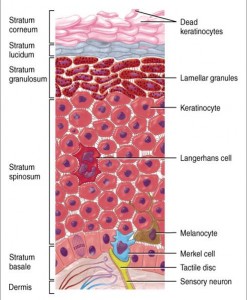Stratum basale Definition
It refers to the basal or the deepest of the five layers of the epidermis. It is also known by the names “germative layer” or “basal layer.” Sometimes, it is also referred to as stratum germinativum.
Stratum basale Location
It is situated between myometrium and the stratum spongiosum.
Stratum basale Anatomy
This epidermal layer comprises only one row of cuboidal or columnar epithelial cells. Half of these cells divide constantly and replace the remaining part of the epidermis that is wearing away. The remaining cells differentiate and go to the next epidermal layer to start the process of maturation.
Stratum basale Function
It forms the outer skin covering in animals. The process of cell division (mitosis) occurs in this layer and replenishes the skin cells.
Role of Stratum Basale in Skin Renewal Process
Stratified epithelium and four types of other cells constitute the epidermis. The epidermal cells are composed of keratinocytes to about 90 percent. The keratinocytes are the cells with horny or finger-like projections that produce keratin, which keeps the skin and other underlying tissues waterproof.
These keratinocytes present in the stratum basale undergo mitosis, thereby helping in the formation of new cells. The formation of the new ones in the basal layer leads to the gradual pushing the previous cells upward towards the stratum spinosum and through it.
Stratum basale Problems
This layer of the epidermis might be involved in various skin disorders, such as Psoriasis and basal cell tumors.
Stratum basale Pictures
You would find these images useful to know about the appearance of this epidermal layer. 
Picture 1 – Stratum basale
Picture 2 – Stratum basale Image
References:
http://en.wikipedia.org/wiki/Stratum_basale
http://www.hcc.bcu.ac.uk/physiology/Skin.htm
http://www.gpnotebook.co.uk/simplepage.cfm?ID=369492030


No comments yet.